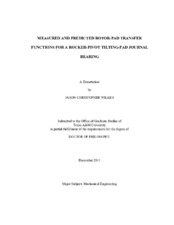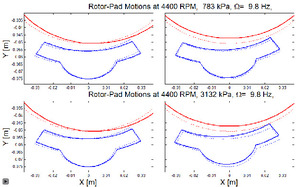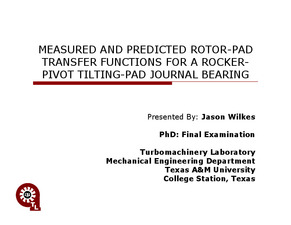| dc.description.abstract | Many researchers have compared predicted stiffness and damping coefficients for tilting-pad journal bearings (TPJBs) to measurements. Most have found that direct damping is consistently overpredicted. The thrust of this research is to explain the difference between measured and predicted stiffness and damping coefficients for TPJBs, and to provide some confidence to designers that TPJB dynamic coefficients can be accurately predicted.
Most analytical models for TPJBs are based on the assumption that explicit dependence on pad motion can be eliminated by assuming harmonic rotor motion such that the amplitude and phase of pad motions resulting from radial and transverse rotor motions are predicted by rotor-pad transfer functions. In short, these transfer functions specify the amplitude and phase of pad motion (angular, radial, translational, etc.) in response to an input rotor motion.
A new pad perturbation model is developed including the effects of angular, radial, and circumferential pad motion and changes in pad clearance due to pad bending compliance. Though all of these pad variables have previously been included in different analyses, there are no publications containing perturbations of all four variables. In addition, previous researchers have only perturbed the journal, while both the bearing and journal motions are perturbed in the present analysis, and the applicability of comparing rotor-perturbed bearing impedance predictions to impedances measured on a bearing-perturbed test rig is discussed. This perturbation model was implemented in a Reynolds-based TPJB code to predict the frequency-dependent bearing impedances and rotor-pad transfer functions.
Direct measurements of pad motion during test excitation were recorded to produce measured transfer functions between rotor and pad motion, and a comparison between these measurements and predictions is given. Motion probes were added to the loaded pad (having the static load vector directed through its pivot) of a 5-pad TPJB to obtain accurate measurement of pad radial and tangential motion, as well as tilt, yaw, and pitch. Strain gages were attached to the side of the loaded pad to measure static and dynamic bending strains, which were then used to determine static and dynamic changes in pad curvature (pad clearance).
Good agreement was found between the amplitude of the measured and predicted transfer functions concerning radial and transverse pad motions throughout the range of speeds and loads tested, while pad tilt was moderately underpredicted.
For the bearing investigated, radial pad motions resulting from pivot compliance were as large as 60% of the radial component of shaft motion when operating at 4400 rpm under heavily loaded conditions. Hence, if a dynamic load applied to the shaft resulted in a shaft displacement of 25 microns (1 mil), the pad would displace radially 15 microns (0.6 mils), and the fluid film height would only decrease by 10 microns (0.4 mils). The consequence of this pad motion is that fluid film stiffness and damping forces produced by relative rotor-pad motions are significantly reduced, resulting in a bearing having significantly less direct stiffness and damping than predicted. A similar effect occurs when shaft motions produce significant changes in pad clearance due to pad compliance. For the pad tested here, the measurements show that predicting TPJB stiffness and damping coefficients without accounting for pad and pivot compliance will produce large errors, and is not advised.
Transverse pad motion was predicted and observed. Based on phase measurements, this motion is lightly damped, and appears to be caused by pivot deflection instead of slipping. Despite observing a lightly damped phase change, an increase in magnitude at this natural frequency was not observed.
Predicted direct stiffness and damping for unit loads from 0-3200 kPa (0-450 psi) fit through 1.5× running speed are within 18% of measurements at 4400 rpm, while predictions at 10200 rpm are within 10% of measurements. This is a significant improvement on the accuracy of predictions cited in literature.
Comparisons between predictions from the developed bearing model neglecting pad, pivot, and pad and pivot flexibility show that predicted direct stiffness and damping coefficients for a model having a rigid pad and pivot are overestimated, respectively, by 202% and 811% at low speeds and large loads, by 176% and 513% at high speeds and high loads, and by 51% and 182% at high speeds and light loads. While the reader is likely questioning the degree to which these predictions are overestimated in regard to previous comparisons, these predictions are based on measured operating bearing clearances, which are 20-30% smaller than the cold bearing clearances that previous comparisons were based on.
The effect of employing a full bearing model (retaining all of the pad degrees of freedom) versus a reduced bearing model (where only journal degrees of freedom are retained) in a stability calculation for a realistic rotor-bearing system is assessed. For the bearing tested, the bearing coefficients reduced at the frequency of the unstable eigenvalue (subsynchronously reduced) predicted a destabilizing cross-coupled stiffness coefficient at the onset of instability within 1% of the full model, while synchronously reduced coefficients for the lightly loaded bearing required 25% more destabilizing cross-coupled stiffness than the full model to cause system instability. This overestimation of stability is due to an increase in predicted direct damping at the synchronous frequency over the subsynchronously reduced value. This increase in direct damping with excitation frequency was also seen in highly loaded test data at frequencies below approximately 2×running speed, after which direct damping decreased with increasing excitation frequency. This effect was more pronounced in predictions, occurring at all load and speed combinations.
The same stability calculation was performed using measured stiffness and damping coefficients at synchronous and subsynchronous frequencies at 10200 rpm. It was found that both the synchronously measured stiffness and damping and predictions using the full bearing model were more conservative than the model using subsynchronously measured stiffness and damping. This outcome contrasts with the comparison between models using synchronously and subsynchronously reduced impedance predictions, which showed the subsynchronously reduced model to be the most conservative. This contrast results from a predicted increase in damping with increasing excitation frequency at all speeds and loads, while this increase in damping with increasing excitation frequency was only measured at the most heavily loaded conditions. | en |




